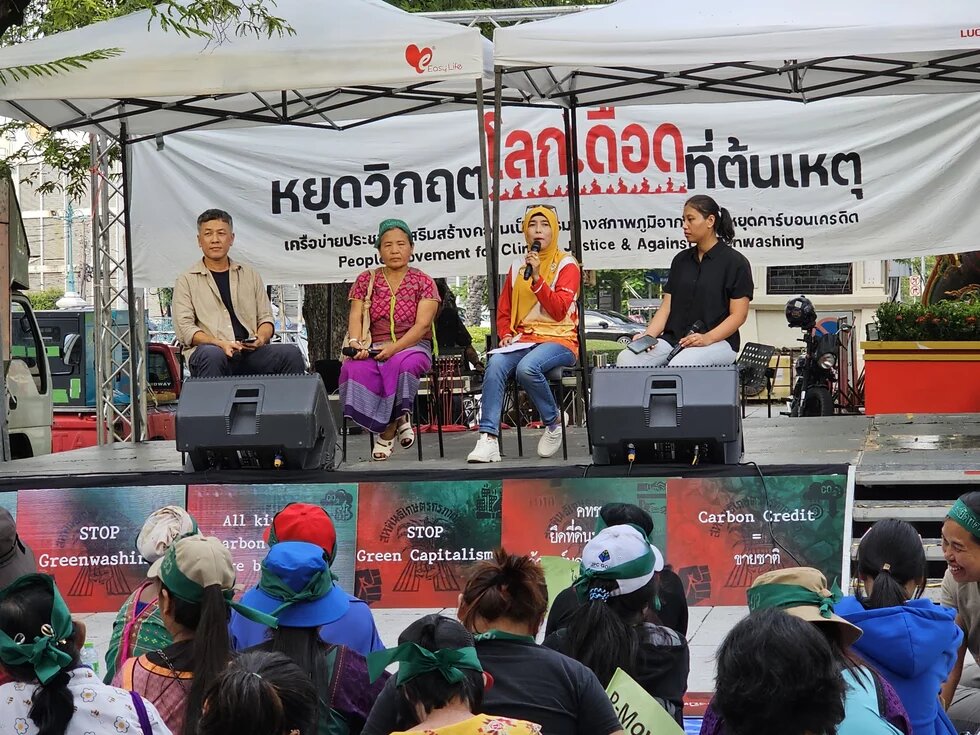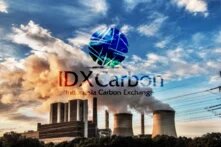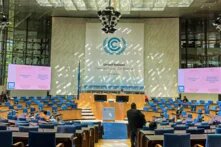
To reduce greenhouse gas emissions, Thailand, like many countries, has developed various approaches to mitigate the climate crisis. One approach is forest-based offsets, which are seen as effective and may provide income for communities. However, these projects, often led by large companies like fossil-fuel companies, to offset their carbon emissions, may seem harmless and profitable but are misaligned with Article 6.8 of the Paris Agreement.
This paper argues that due to the market-based orientation of such projects, these may have the potential for abuse and endanger community rights and justice, particularly for those whose livelihoods depend on the forests.

The carbon credit market has become a prominent approach to offsetting carbon emissions in Thailand. Under the Paris Agreement, Thailand has committed to achieving carbon neutrality by 2050 and net-zero greenhouse gas emissions by 2065. Additionally, Thailand has set an intermediate goal to reduce greenhouse gas emissions by up to 40% by 2030. To meet these climate goals, the Thai government plans to expand green areas to cover up to 55% of the total land area to offset carbon emissions.
However, forest-based offsets have faced criticism due to concerns about greenwashing, land grabs of community lands and adverse effects on ethnic and marginalized forest communities with limited negotiation power.
Who are the major emitters of carbon in Thailand?
Thailand’s growing economy remains heavily reliant on natural gas for electricity and heat generation, making it the largest contributor to Thailand’s greenhouse gas emissions. The 2018 greenhouse gas inventory revealed total greenhouse gas emissions in Thailand were 280,728.34 GgCO2eq or greenhouse gases carbon dioxide equivalent[i]. The energy sector was the major contributor to Thailand’s emissions, accounting for 67.14% of total emissions in 2000, and increasing to 69.06% in 2018.
In the same period, the share of emissions from the agriculture sector decreased from 19.95% in 2000 to 15.69% in 2018, while the share of emissions from the industrial processes and product use (IPPU) and waste sectors increased slightly from 4.26% in 2000 to 4.48% in 2018. In contrast, forests and trees absorb more greenhouse gases than they emitted, contributing to a net reduction of 91,988.52 GgCO2eq in the total emissions.
According to the second version of the NDC[ii], Thailand intends to reduce its greenhouse gas emissions by 30 percent from the projected business-as-usual (BAU)[1] level by 2030. This contribution could increase up to 40 percent, subject to adequate and enhanced access to technology development and transfer, financial resources and capacity building support.
However, it is anticipated that the trend of energy consumption in Thailand is unlikely to change within the next 10-15 years, as new infrastructure needed to support the transition to low carbon fuels and renewable sources will take some time to ramp up[iii]. Given the challenge in energy related structural improvement, the Thai government has instead developed voluntary actions such as the carbon market and carbon label schemes aiming for mitigating greenhouse gas emissions[iv].
Forest offsetting: for whom?
Thailand has turned to forest-based offsetting measures to stay on track with its climate targets. To achieve the net carbon sinks of 120 million tonnes of carbon dioxide equivalent as committed in the Paris Agreement, the government seeks to increase forest cover and green areas up to 55% of the total land area. The ambition of green offsetting is highlighted in the 20-Year National Strategy as one of the key components for climate change mitigation.
According to the forestry strategy, approximately 30 million rai of newly planted and restored forests are expected by 2030. This has driven the demand for land by government departments and companies seeking to offset their emissions from natural carbon sinks.
The Thai government aims to increase forest cover and green areas by planting trees and restoring the green spaces by 2037. These are categorized into three types: natural forests, economic forests and urban and community green spaces. Natural forests accounted for 35%, or approximately 113.23 million rai, economic forests accounted for 15% or approximately 48.52 million rai; and urban and community green spaces accounted for 5% or 16.17 million rai. It is presented in the table below:
Estimated targets for forest cover and green areas by 2037
| Category of green areas | Targeted areas (million rai) |
Remaining forest cover (million rai) | Planted forest areas (million rai) |
| Natural forests | 113.23 | 102.04 | 11.19 |
| Economic forests | 48.52 | 32.65 | 15.87 |
| Urban and community green spaces | 16.17 | 13.17 | 3.00 |
| Total | 177.92 (55%) | 147.86(46%) | 30.06 |
Source: modified by the author from the National Strategy of Thailand (2018-2037)
Forest carbon projects allow private companies and corporations to invest in forest restoration in exchange for earning carbon credits to offset emissions caused by their operations. For example, a petroleum company [2] signed an MoU (Memorandum of Understanding) agreement with the responsible forestry agencies to collaborate on a forest conservation and restoration project. The project aims to plant and restore 2 million rai of natural forests, through which they expect to receive carbon credits to offset 4.15 million tonnes of carbon dioxide equivalent in total emissions by 2030.
However, forest-based carbon offsetting could lead to land grabbing of community land and pose a threat to local livelihoods. This is because the offsetting project requires sizeable area of land for keeping CO2 on the ground or for planting trees that extract CO2 from the air. Targeted areas for the projects are in conservation forest zones and coastal and mangrove forest areas. In particular, forest-dependent communities like Karen ethnic group who are living inside state conservation areas are at risk of losing control over their land and resources needed for their livelihoods.
T-VER carbon market: greenwashing trap?
The Thai government launched the carbon market trade because it was thought to be the most efficient way to reduce carbon emission. The proponents see the carbon market as a financial incentive for emitters to make decisions on their emission strategy. However, Thailand’s voluntary carbon markets are at risk of fraud and greenwashing due to legislation and policy uncertainty. However, the government frameworks and guidelines for ensuring the integrity, transparency, and effectiveness of the voluntary carbon market are not yet clearly established. More importantly, the standards for quantifying, verifying and reporting carbon reductions and removal, addressing the key issue of double counting, and ensuring that carbon credits represent real, measurable and additional climate benefits, are not adequate.
Since 2012, the Thai government has developed a domestic voluntary carbon credit market or the Thailand Voluntary Emission Reduction (T-VER). This voluntary market platform is regulated by the Thailand Greenhouse Gas Management Organization (TGO), which is under the Ministry of Natural Resources and Environment. The TGO has prescribed rules and procedures for project development, GHG emission reduction methodology, and certification of emission reduction credits.
Within Thailand, carbon credits can be traded through T-VER, which comprises two categories: standard T-VER and premium T-VER. It is claimed that the latter could generate higher quality credits to meet international standards. With the support of universities and the private sector, more than 460 projects were expected to reduce up to 13 million tonnes of carbon dioxide equivalents in total[v].
In the forestry sector, there are 87 projects with approximately 121 community forests registered with T-VER programme. Of these only eight projects received certification of carbon credits which can be traded in carbon markets.
Some NGO networks in Thailand have expressed their concerns about the potential abuse of community rights. With the introduction and implementation of forest carbon credit projects, the rights of local communities to access their community forests will be diminished and subject to new regulations on carbon credit governance. For example, the members of community forest groups may not be allowed to cut down and harvest trees within the boundaries of carbon credits project for their household use.
The complexities of regulations and high costs involved in TVER registration are also of great concern. In a research carried out by the Association of Consumer Protection, it was found that forest communities who had already registered community forests with T-VER have reported that they need more information on this topic to understand what these markets might mean for them. The technical and complex language that is often used by officials regarding these market mechanisms does not help.
Case Study of Ban Khong Ta Bang
Ban Khong Ta Bang, located in Tha Yang district of Phetchaburi province, has been involved in the T-VER program since 2015. It became the first community forest offsetting project in Thailand, according to the Royal Forest Department (RFD).
With help from the RFD, Kasetsart University, the Mae Fah Luang Foundation, and the Ratch Group, the community registered 1,397 rai of community forest areas with a T-VER project. They received carbon credit certification for 5,259 tonnes of carbon dioxide equivalent. It was reported that three private companies, have expressed interest in buying carbon credits from Ban Khong Ta Bang, valued at 7.09 million baht in total[vi].
According to RFD officials, Ban Khong Ta Bang explicitly shows a win-win scenario of green offsets. The community, which keeps the forest healthy, could get direct income by selling carbon credits while at the same time helping the Thai government to achieve its climate targets of carbon neutrality by 2050 and net-zero emissions by 2065.
The claim of a win-win situation made by officials was a half-truth and misleading. It is true that the community is benefiting financially from their efforts to forest conservation. However, the forest-based-offsetting project allows the companies to pay to pollute, while doing little to tackle their emissions and climate crisis. In this case, the buying companies are continuing to drill and emit more CO2 into the air. Forest offsets like this serve to greenwash companies and allow them to self-classify as carbon neutral.
Forest-based carbon credit projects may seem attractive to the forest communities like Ban Khong Ta Bang owing to the promises of money and better living conditions. However, the community was obliged to take care of the trees continuously for seven years according to the terms of contract. There is still some doubt as to who will be responsible if the trees are damaged or destroyed.
Towards the rights-based solutions
Market-based mechanisms, which are seen as the only way to generate income for community-based forest conservation, have proven to have serious flaws and present risks to community livelihoods. Thailand needs to move beyond the obsession with carbon offset markets and embrace a diverse range of the rights-based and non-market mechanisms to climate actions. We definitely need real win-win solutions that avoid compensation-based activities, which empower the rights of local and ethnic communities to access their land and resources.
Adopting a rights-based approach to climate action is one of the most strategic and effective means to promote community rights to land and resources while addressing climate challenges. We realize that ethnic and forest-dependent communities that have contributed the least to climate change are often disproportionately affected by the impacts and tend to bear a significant burden from those impacts.There is an urgent need for improved and clear regulations and guidelines for forest carbon projects that address the root cause of inequality and vulnerability, supported by strong social and environmental safeguards to ensure that the implementation of climate action respects community and human rights.
Article 6.8 of the 2015 Paris Agreement presents different ways and opportunities for participant countries to collaboratively implement their NDCs[3] towards the achievement of climate targets. It highlights the integrated, holistic, and bottom-up approach to climate mitigation and sustainable adaptation, which does not rely on market approaches. The non-market approaches (NMAs), together with right political will, could provide unconditional development support and assistance in better-defining adaptation needs and loss and damage claims.
At present, the proper definition of NMAs has not been clearly defined. Article 6.8 of the Paris Agreement indicates that “Parties recognize the importance of integrated, holistic and balanced non-market approaches being available to Parties to assist in the implementation of their nationally determined contributions”. This means that the non-market approaches can be anything and everything, provided it’s not market based. Some observed that the concept of NMAs emerged in the UNFCCC[4] negotiations as a proposal for climate solutions by countries like Bolivia and Venezuela, which strongly opposed the use of market approaches to climate mitigation and emissions reduction. These countries claimed that market mechanisms essentially promote the right to pollute and commodify the climate. Therefore, NMAs can be a pathway to real solutions that respect a rights-based and gender just approach to international climate mitigation and adaptation cooperation.
One example of NMAs is securing land tenure and resource rights of vulnerable groups including local and ethnic communities. As discussed by Greenpeace and the Climate Land Ambition and Rights Alliance (CLARA)[vii], there is substantial evidence showing that securing the land tenure and resource rights of Indigenous Peoples and local communities results in lower rates of deforestation and soil degradation and better protection of the biodiversity and ecosystem functions upon which these communities depend. The implementation of such approaches would create more resilient landscapes, directly contributing to climate change adaptation and mitigation.
__
Dr. Surin Onprom is a human geographer with strong interests in natural resource governance, forest and land tenure and environmental politics, with more than 20 years’ experience in action research, capacity building, networking, and project management.
Disclaimer: This published work was prepared with the support of the Heinrich Böll Stiftung. The views and analysis contained in the work are those of the author and do not necessarily represent the views of the foundation. The author is responsible for any liability claims against copyright breaches of graphics, photograph, images, audio, and text used.
References
[1] Business-as-usual projection from reference year 2005 in the absence of major climate change policies (BAU 2030: approx. 555 MtCO2e)
[2] Petroleum Authority of Thailand
[3] A Nationally Determined Contribution (NDC) is a country's plan for reducing greenhouse gas emissions and adapting to climate change as part of the Paris Agreement.
[4] UNFCCC stands for the Parties to the United Nations Framework Convention on Climate Change.
[i] Thiland’s Fouth Biennual Update Report.
[ii] Thailand’s Long-Term Low Greenhouse Gas Emission Development Strategy (revised version). Ministry of Natural Resources and Environment (2022).
[iii] Thailand’s Energy Transition 2024 Outlook. Chandler MHM Limited (2023).
[iv] https://thaicarbonlabel.tgo.or.th/index.php?lang=EN&mod=Y0hKdlpIVmpkSE5mYVhNPQ.
[v] https://ghgreduction.tgo.or.th/th/tver-database-and-statistics/t-ver-project-stat-report.html.
[vi] https://www.bangkokpost.com/thailand/general/2873138/carbon-credits-key-to-winning-climate-fight.
[vii] Greenpeace





